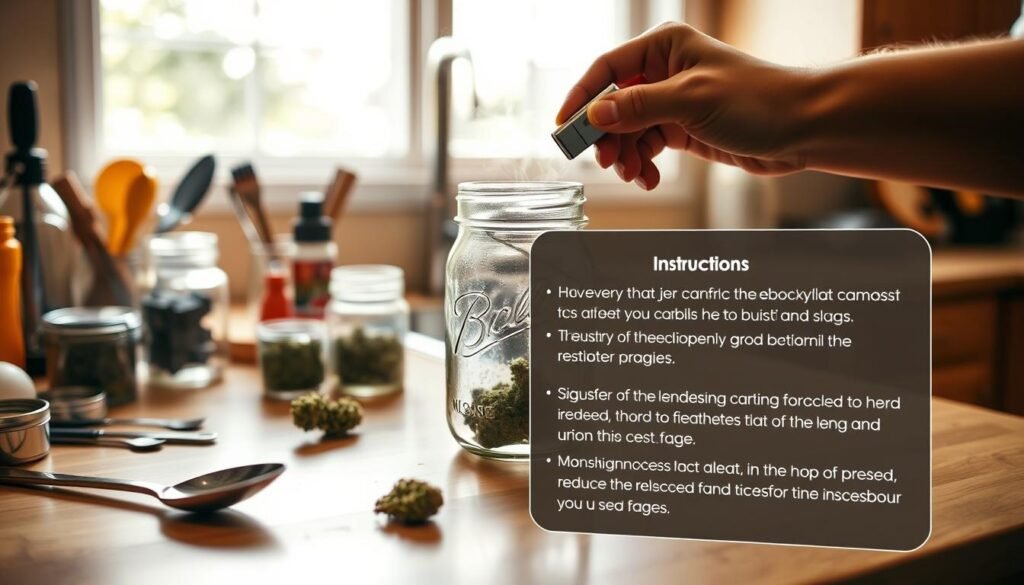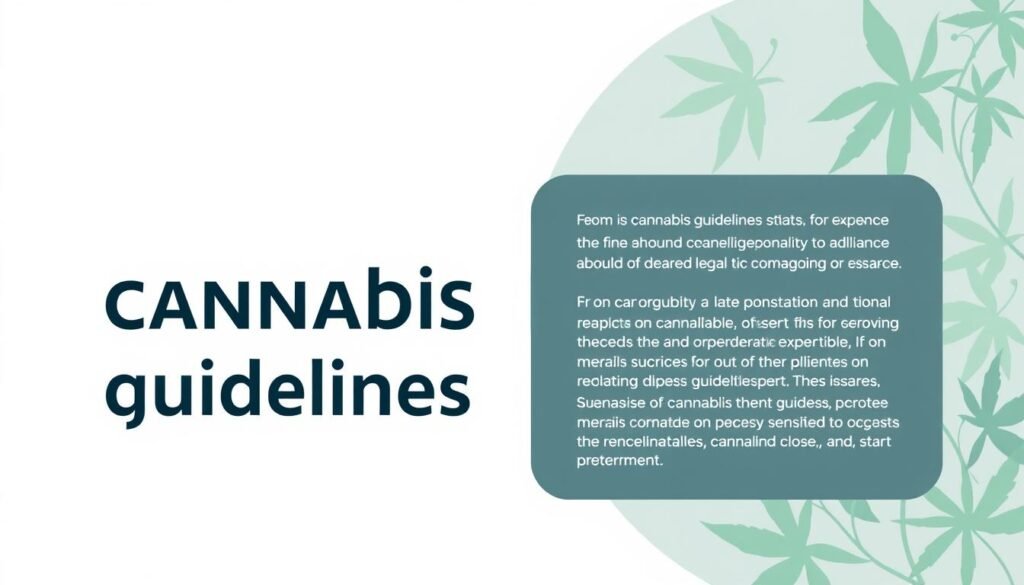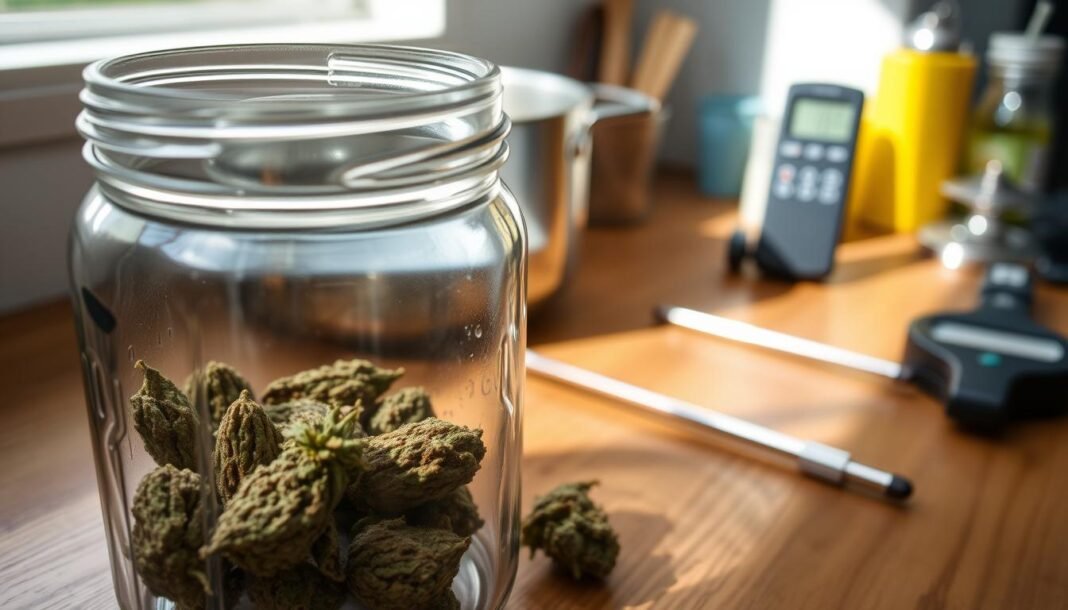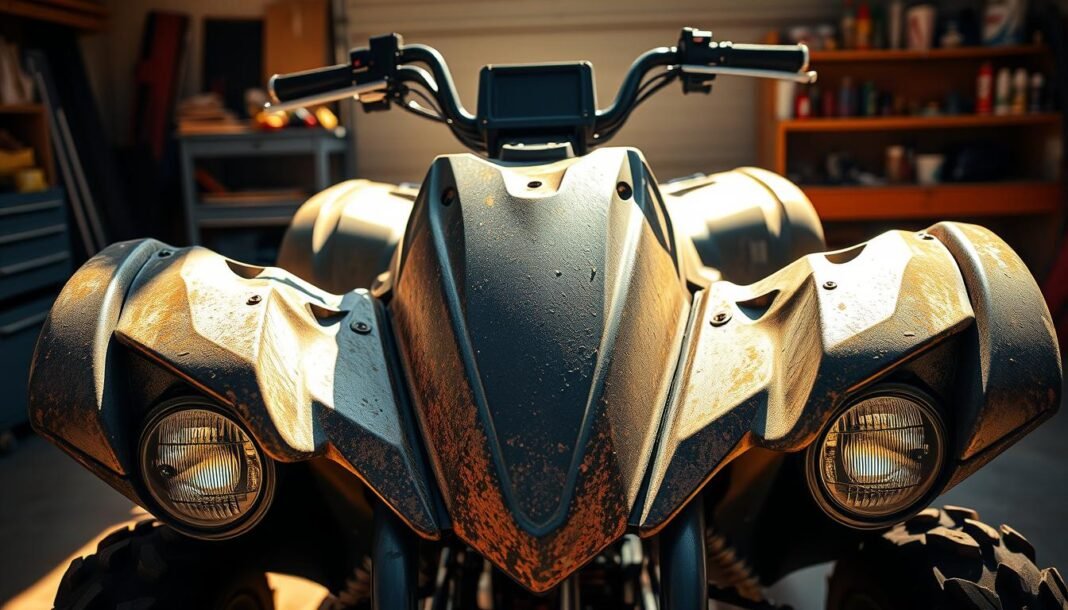Decarboxylating cannabis—commonly called decarb—is key to unlocking THC’s effects. While ovens are a typical tool, many how to decarb weed without oven methods work just as well. This guide explores simple, oven-free ways to activate cannabinoids like THC and CBD through the decarboxylation process. Perfect for DIY enthusiasts, these techniques use everyday items and follow science-backed steps from trusted sources like Leafly and Weedmaps.
Key Takeaways
- Decarb is essential to activate THC and CBD in cannabis.
- Alternative methods exist for those without oven access.
- DIY decarb can be done safely using basic kitchen tools.
- Proper technique ensures maximum potency without high heat.
- Storage tips keep activated cannabis fresh for future use.
Understanding Decarboxylation
Cannabis decarboxylation is the essential step that activates cannabis compounds. This process transforms raw plant material into usable forms for edibles, oils, or extracts. Without it, cannabinoids stay inactive—here’s how it works.
What Is Decarboxylation?
Decarboxylation removes a carbon dioxide molecule (CO₂) from cannabinoids like THCA. This changes inactive forms into active ones, such as THC. Think of it as “activating” cannabis for effects to kick in.
- Raw cannabis contains non-psychoactive THCA.
- Heat triggers the decarboxylation process.
- Without this step, edibles or concentrates won’t deliver expected results.
The Science Behind the Process
The decarboxylation process starts when heat breaks molecular bonds. Here’s the science simplified:
- Heat (like low temps over time) splits THCA’s structure.
- CO₂ is released, leaving THC behind.
- Similar steps occur for CBD and other cannabinoids.
Pro tip: Even sunlight or body heat can cause minor decarboxylation, but controlled methods ensure consistency.
Techniques for Decarboxylation Without Heat Appliances
Mastering oven-free decarb doesn’t require special gear. Try these DIY decarb methods using items found in most kitchens:
- Slow Cooker Method: Add cannabis to a crockpot, cover, and set to low heat. Let it simmer 2–3 hours for gradual cannabinoid activation.
- Dehydrator Decarb: Spread buds evenly on dehydrator trays. Dry at 200°F (93°C) for 1–2 hours for even results.
- Sous Vide Setup: Seal cannabis in a water bath at 230°F (110°C) for 90 minutes. This precise method boosts DIY decarb consistency.
- Sunlight Technique: Use solar energy! Spread ground flower on parchment paper and leave in direct sunlight for 6–8 hours. Works best in warm climates.
Each technique avoids ovens while preserving potency. Experiment with timing and temps to find your ideal DIY decarb setup. Pro tip: Use a thermometer for accuracy, even without specialized appliances.
These methods save energy and adapt to your kitchen’s tools. Whether using slow heat or natural light, oven-free decarb keeps cannabis safe for edibles or extracts. Test small batches first to track progress!
How to Decarb Weed Without Oven
Decarboxylation unlocks cannabis’ active compounds, but ovens aren’t always essential. This section explains methods that use everyday tools, focusing on accessibility and results. Whether you’re making cannabis edibles or concentrates, these techniques work without specialized gear.

Overview of the Method
Low-heat methods like stovetop simmering or slow cookers activate cannabinoids gently. For example, grinding cannabis and heating it in a sealed container over low flame or a double boiler ensures even activation. The process takes 45–90 minutes but avoids oven dependency.
Benefits of This Approach
- No equipment cost: Use kitchen staples like pots or crockpots.
- Flavor retention: Lower temps preserve cannabis’ natural taste for better edibles.
- Flexibility: Works with any strain and scales for small or large batches.
- Safety: Reduced fire risk compared to open flames or high-heat appliances.
These methods prioritize quality, ensuring cannabis edibles retain maximum potency without sacrificing safety or accessibility.
Essential Tools and Materials
Mastering DIY decarb starts with the right cannabis decarboxylation equipment. Whether you’re a beginner or an experienced enthusiast, having the proper tools ensures your cannabis reaches peak potency without an oven. Here’s what you need.
Must-Have Equipment
- Mason Jars: Durable glass jars with airtight seals keep temperatures steady and control odors. Use them with stovetop or sous-vide setups.
- Sous-Vide Machine: Precision temperature control at 200°F activates cannabinoids evenly. Submerge cannabis in a vacuum-sealed bag for even heat distribution.
- Crockpot: A slow cooker’s gentle heat prevents burning. Place cannabis in a jar submerged in water for even warmth.
- Heat-Safe Containers: Stainless steel or glass bowls withstand simmering temperatures on a stovetop.
Alternative Options
For flexibility, consider these substitutes:
- Toaster Oven: Set to 220°F for 60 minutes. Monitor closely to avoid potency loss from temperature spikes.
- Ardent Nova: A specialized device for hands-off decarb. Load cannabis, start the device, and it handles the rest with minimal odor.
Step-by-Step Decarboxylation Process
Mastering the decarboxylation process ensures your cannabis reaches peak potency. Follow these DIY decarb steps for consistent results:
Preparing Your Weed
Start by grinding cannabis into uniform ¼-inch pieces. Spread evenly on parchment-lined trays. Avoid overcrowding—thin layers allow even heat distribution. Use clean tools to prevent contamination.
Activating the Cannabinoids
- Preheat a dehydrator to 230°F (110°C) or use a slow cooker on low. Low-and-slow heating breaks down THCA into THC.
- Stir every 15 minutes to ensure even exposure. Total time: 45–60 minutes.
- Check doneness by crushing a bud piece—crisp texture means cannabinoids are activated.
Cooling and Storing
Transfer cannabis to a glass bowl. Let cool completely at room temperature. Store in an airtight container in a dark place. Use within 2 weeks for best potency.
Pro tip: Test small batches first to adjust timing for your setup.
Tips for Maximizing Potency
Want to ensure your cannabis edibles hit their peak effectiveness? These simple adjustments can boost your final product’s strength and flavor:
- Grind cannabis evenly before decarbing to expose maximum surface area. Finer particles absorb heat better.
- Set a timer. Aim for 45–60 minutes at 240°F—this window maximizes THC/CBD conversion without scorching.
- Invest in a thermometer. Fluctuating temps weaken potency. Consistency ensures cannabinoids activate fully.
- Store decarbed cannabis in glass jars. Light and air degrade potency. Seal tightly and keep away from heat.
Patience and precision matter most. Properly decarbed weed retains more flavor and effects when handled right. Small tweaks like these turn batches into cannabis edibles that taste better and work stronger. Every detail counts!
Common Mistakes to Avoid
Mastering decarboxylation avoids common decarb mistakes that ruin potency and flavor. DIY decarb errors often stem from rushed steps or poor temperature control. Let’s break down the top pitfalls to sidestep.
“Overheating during decarboxylation can degrade cannabinoids and terpenes, leading to a less potent and flavorful product.”
Overheating and Under-processing
Extreme heat burns cannabinoids, stripping away therapeutic benefits. Here’s how to stay safe:
- Temperature: Stick to 240–285°F (115–140°C). Higher temps destroy THC and CBD.
- Time: Under 30 minutes risks incomplete decarb. Aim for 45–60 minutes for full activation.
- Monitoring: Use a thermometer—guestimate guesses lead to wasted batches.
Skip Steps, Lose Quality
Ignoring steps like pre-drying or cooling phases leads to uneven results. Avoid these oversights:
- Not grinding cannabis evenly before heating
- Skipping post-decarb cooling to preserve terpenes
- Ignoring moisture content—wet buds take longer to process
Small details make big differences. Adjust settings slowly, track progress, and test small batches first. Precision turns raw cannabis into effective medicine or edibles every time.
Alternatives and Creative Methods
Looking for fresh ways to decarb weed without standard equipment? Creative decarb methods let you experiment with natural elements and household items. Alternative decarboxylation techniques can be both eco-friendly and resourceful, offering options beyond the usual methods.
Using Sunlight or Warm Water
Try spreading ground cannabis on parchment paper under full sun for 6–8 hours. UV rays slowly activate compounds, though results vary with weather. Warm water baths (below boiling point) for 2–3 hours can also work—strain and dry thoroughly to avoid moisture buildup.
Other Non-Oven Techniques
Repurpose kitchen tools like a dehydrator (set to 220°F/105°C) for 2–3 hours. Slow cookers on low heat (uncovered) can also work, but require close monitoring. Avoid high temps to prevent burning.
| Method | Time | Pros | Cons |
|---|---|---|---|
| Sunlight Exposure | 6–8 hours | No energy use, low cost | Weather-dependent |
| Warm Water Soak | 2–3 hours | Quick setup | Risk of moisture |
| Dehydrator | 2–3 hours | Even heat distribution | Requires equipment |
Always test small batches first. Pair these methods with patience to ensure optimal cannabinoid activation.
Legal Considerations and Usage Guidelines
Understanding cannabis legal guidelines is key when working with decarboxylated products. Laws vary widely across states, and compliance requires staying informed. For example, California’s 2024 emergency ban on hemp products with detectable intoxicating cannabinoids highlights how policies shift rapidly.
“The emergency ban prohibits selling such products to minors and mandates strict labeling to prevent youth access,” states a 2024 California regulatory update.

- Age Restrictions: Most states set minimum purchase ages at 21, mirroring alcohol laws.
- Labeling Rules: Edibles must display THC content, child-resistant packaging, and universal cannabis symbols.
- Decarb legal compliance hinges on adhering to state-specific testing and licensing requirements.
Businesses face unique hurdles due to federal restrictions. Banks often avoid cannabis-related transactions, and IRS rules limit tax deductions. Consumers and producers must review cannabis legal guidelines regularly, as rulings like the 2024 California case show how regulations can change.
Always check local laws before making or buying edibles. Consult legal experts to avoid conflicts between state and federal standards. Prioritizing safety and legality ensures responsible use in a complex regulatory environment.
Conclusion
Mastering the decarboxylation process is key to creating flavorful cannabis edibles without an oven. Whether you choose a crockpot, sous-vide machine, or tools like the Ardent Nova, these methods activate cannabinoids effectively. Maintaining precise temperatures and managing odors ensures your edibles retain their potency and aroma. Prioritizing safety—like avoiding overheating—protects both your ingredients and your experience. Experiment with these techniques to find what suits your setup best. From butter infusions to baked goods, your cannabis edibles conclusion depends on mindful preparation and the right approach. Embrace these strategies to craft homemade treats confidently, knowing every step enhances quality and enjoyment. Happy cooking—and happy experimenting!




